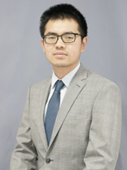 |
Mingjun Huang obtained his B.S. at Peking University in 2010. Then he worked on macromolecular self-assembly with Prof. Stephen Z.D. Cheng at the University of Akron, and obtained his PhD degree in Polymer Chemistry in 2015. After that he moved to MIT and joined the Jeremiah Johnson group as a postdoc, working on battery electrolyte material development. From February 2019, Mingjun started his independent career in South China University of Technology (SCUT). He is currently a professor in South China Advanced Institute for Soft Matter Science and Technology & School of Emergent Soft Matter. He mainly focuses on the novel functional soft matter development within the scope of optics, electric, and energy storage. The main research projects involve: 1) Liquid crystals/liquid crystal polymers with unprecedented structures and properties for applications in optical and electric materials; 2) Self-assembly study of macromolecules with precise chemical structures in condensed states; 3) Design of functional polymer materials for specific needs in display technology and microelectronic industry.
Read Mingjun Huang’s Emerging Investigator’s article ‘ Perfluorocyclobutyl-containing transparent polyimides with low dielectric constant and low dielectric loss‘ |
Read our interview with Mingjun below.
1. How do you feel about Polymer Chemistry as a place to publish research on this topic?
In my mind, Polymer Chemistry is a leading polymer journal for design, synthesis, structure and property study of polymer materials. Particularly for polyimide research, novelty for chemical structure as well as excellent material property is usually required. I feel a great sense of achievement for publication of this topic on this journal.
2. What aspect of your work are you most excited about at the moment and what do you find most challenging about your research?
As a polymer chemist, I am most excited about the successful collection of the new polymer samples, after a long journey of monomer design, synthesis and polymerization. I prefer to design monomer structures with simplicity and functionality.
In my research of polyimide materials, the most challenging part is the monomer structure design, i.e. how to balance the polymerization reactivity and targeted functionality in new monomer structure. Obtaining rather high purity of new monomers is also not an easy task for this step polymerization.
3. In your opinion, what are the most important questions to be asked/answered in this field of research?
Polyimides have great potentials for applications in microelectronic industry or flexible display technology. In my opinion, the most important question is how to integrate all the required high performances (e.g. good processibility, high transparency, low dielectric, high glass transition temperature, high thermal degradation stability) in one single material through either chemical structure or composite formulation tuning. A shortage in any important material property would prevent its practical application.
4. Can you share one piece of career-related advice or wisdom with other early career scientists?
I believe in-depth discussions with senior people in similar research area would be very helpful for seeking the entry point or inspiration of new ideas.










